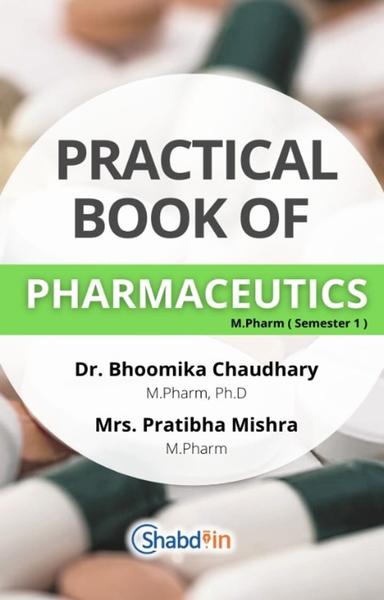AIM: To perform the dissolution profile of Sustained release (SR) marketed formulation of given tablets
REQUIREMENTS:
Apparatus: In vitro dissolution test apparatus I (USP), UV-spectrophotometer, volumetric flasks, pipette, beakers.
Chemicals: Diclofenac (active pharmaceutical ingredient), marketed Diclofenac tablets, distilled water, 0.1 N HCl.
REFERENCES:
1. Dr. A. Y. Yadav, V. B. Yadav, Experimental biopharmaceutics and pharmacokinetics.
2. Govt. of India, Ministry of Health and family welfare, I. P. Commission, Gaziabad, I.P. 2010, Vol. III, Page no. 2187-2188.
THEORY:
Dissolution is process in which a solid substance solubilise in a given solvent i.e. mass transfer from the solid surface to the liquid phase. Several theories to explain drug dissolution have been proposed. Some of the important are as follows:
Diffusion layer model / Film theory:
This theory is based on Fick’s law of diffusion. Nernst and Bruner incorporated Fick’s first law of diffusion and modified the Noyes- Whitney equation to:
𝑑𝐶/𝑑𝑇= 𝐷𝐴𝐾(𝐶𝑠 − 𝐶𝑏)/ 𝑉ℎ
Where,
D = diffusion coefficient of the drug
A = Surface area of dissolving solid
K = Intrinsic dissolution rate constant
V = Volume of dissolution medium
h = Thickness of stagnant layer
(Cs-Cb) = Concentration gradient for diffusion of
The difference between Dissolution and Disintegration
What is D value.
Danckwert’s model / Surface renewal theory: The solvent packets are exposed to new solid surface each time, the theory is called as surface renewal theory.
The Danckwert’s model is expressed by equation:
𝑉𝑑𝐶/𝑑𝑡 = 𝑑𝑚 /𝑑𝑡 = 𝐴(𝐶𝑠 − 𝐶𝑏) √𝛾𝐷
Where,
m = mass of solid dissolved
g = rate of surface renewal
Interfacial barrier model / Double barrier theory: According to the interfacial barrier model, an intermediate concentration can exist at the interface as a result of salvation mechanism and is a function of solubility rather diffusion. When considering the dissolution of crystal, each face of the crystal will have different interfacial barrier. Such concept is given by the following equation:
𝐺 = 𝐾𝑖(𝐶𝑠 − 𝐶𝑏)
Where,
G=Dissolution rate per unit area.
Ki= Effective interfacial transport constant.
Objectives of dissolution profile comparison:
Comparison of in vitro dissolution profile of test drug product and approved drug product are useful for-
Development of bioequivalent drug productDemonstrating equivalence after change in formulation of drug product. Behaviour of drug product of lower dose strength in proportion to higher dose strength drug product containing the same active ingredient and excipients Methods for comparison of dissolution profile:
The similarity of the dissolution profiles in particular dissolution testing conditions is evaluated using the similarity factor (f2). It is the mathematical comparison between the drug release profile of different brands of the same drug product or comparison between the release profile of test and reference sample or it is used in the comparative dissolution profile study for predicting stability by comparison of initial dissolution profile and dissolution profile after stability testing period.
Similarity factor (f2) calculated as below:
F2 = 50 × Log [1+ (1/n) Σ [Rt-Tt]2]-0.5×100
Where, n is the sample number, Rt and Tt are the % of reference and test drug release at different time intervals. This similarity factor is logarithmic reciprocal of the square root transformation of the sum of the squared error and is the measurement of the similarity in the % dissolved between two curves. The results are values between 0 and 100. The values of f2 is 100 when the test and reference profile s are identical and approaches zero as the dissimilarity increases. An average difference is of 10% at all time points results in f2 value is 50 . The f2 value between 50 and 100 therefore suggest the similarity between two dissolution profiles. F2 value greater than 50 (50-100). Ensure the similarity of equivalence of two curves. The dissimilar dissolution profile is considered if the value of f2 is below 50 (0-50). This factor is endorsed by the FDA as acceptable and preferred method for dissolution profile comparison. The main advantages of the f2 equation are that it is easy to compute and provide a single number to describe the comparison of dissolution profile data.
The evaluation of similarity between dissolution is based on following parameters:
Minimum of three dissolution time points are measured Number of drug product tested for dissolution is 12 for both test and reference. Not more than one mean value of > 85% dissolved for each product. Standard deviation of mean of any product should not be more than 10% from second to last dissolution time point. PROCEDURE:
Standard calibration curve of in 0.1N HCl:
Preparation of stock solution:
Weigh accurately 10 mg of Diclofenac.Transfer it to 100 ml volumetric flask, and add 0.1N HCLSonicate to dissolve Diclofenac filter this solution through 0.45 micron membrane filter to get a clear solution. 4. Concentration of stock solution is 100ug/ml.
Preparation of working solutions:
From the prepared stock solution pipette out 0.5, 1, 1.5, 2, 2.5ml.transfer to 10 ml volumetric flask and make up the volume upto 10 ml with 0.1N HCl to get 5, 10, 15, 20, 25 ug/ml concentration of diclofenac respectively. Measure the absorbance at 254nm by using UV spectrophotometer. Plot the curve of concentration (x-axis) vs. absorbance (y-axis). Find out the equation of the line. In vitro dissolution study:
1. Study the dissolution rate of P1 tablet measure using dissolution apparatus USP Type I.
2. Carry out dissolution study using 900 ml of 0.1N HCl at 37±0.50C at 100 r.p.m.
3. withdraw 5 ml samples after 5, 15, 30, 45, 60 min and replace each time with 5 ml fresh 0.1 N HCl.
4. Filter the solution immediately through 0.45um membrane filter, take 1 ml of filtered sample dilute upto 10 ml and determine the concentration of P1 spectrophotometrically at 254nm.
RESULT:
Remark:
Practical Performance (2) | Conduct in Lab (2) | Journal (2) | Observations and Results (2) | Viva-Voce (2) | Total (10) | Signature of Faculty In charge |
| | | | | | |
Observation:
HARDNESS (Standard)
S.NO. | WEIGHT | PRESSURE | HARDNESS | MEAN |
| | |
| | | | | | |
| | | | | | |
| | | | | | |
HARDNESS (Granules sample)
S.NO. | WEIGHT | PRESSURE | THICKNESS | MEAN |
| | |
| | | | | | |
| | | | | | |
| | | | | | |
THICKNESS (Standard)
S.NO. | WEIGHT | PRESSURE | HARDNESS | MEAN |
| | |
| | | | | | |
| | | | | | |
| | | | | | |
THICKNESS (Granules sample)
S.NO. | WEIGHT | PRESSURE | THICKNESS | MEAN |
| | |
| | | | | | |
| | | | | | |
| | | | | | |
| | | | | | |
Dissolution Studies
Time(min) | Absorbance | Conc in microgm | Cumulative conc | Conc in Dissolution media | % drug release |
15 | | | | | |
30 | | | | | |
45 | | | | | |
60 | | | | | |
EXPERIMENT NO: 13








